The completion of the National Assembly
The 1980s saw the completion of construction for Bangladesh's parliament building
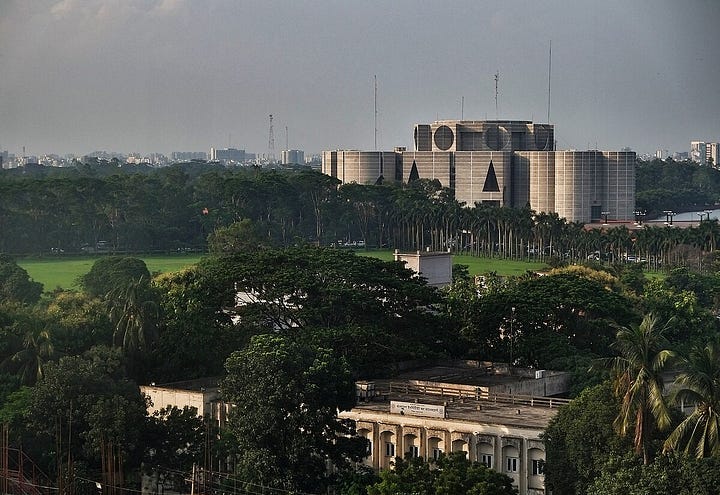

The Parliament of Bangladesh sits in one of the largest legislative complexes in the world. Spread across a sprawling 215 acres of parks and gardens in the middle of Dhaka, the Jatiya Sangshad Bhaban (National Parliament House) is the crown jewel of a vast capital designed by the renowned architect Louis I. Kahn. Today, this complex is known as Sher-e-Bangla Nagar which translates as the City of the Lion of Bengal. The Lion of Bengal refers to A. K. Fazlul Huq who was the first Prime Minister of Bengal.
The project dates back to 1959 when President Ayub Khan of undivided Pakistan envisioned Dhaka as the legislative capital of East and West Pakistan. It was planned for Dhaka to host the federal parliament of Pakistan. The 1962 Constitution of Pakistan stipulated that “the principal seat of the National Assembly shall be at Dacca”. The city was declared as the “second capital” after Islamabad.
Ayub Khan envisioned a befitting project for his second capital. He looked to some of the world’s most foremost architects to design the National Assembly building in Dhaka. The government approached the Bengali modernist architect Muzharul Islam. Initial choices considered Alvar Aalto and Le Corbusier. Islam eventually settled on Louis Kahn, his former teacher at Yale who was known for his monumental works.
It took 20 years to complete construction. The project was halted by the Liberation War in 1971 but commenced soon after the establishment of Bangladesh. The project is widely considered as Louis Kahn’s seminal masterpiece. Kahn died in 1974 before the completion of the national assembly. Kahn had a brilliant ability to combine his architectural designs with the infiltration of natural light which is reflected in the design of the national assembly. The design of the capital complex also incorporates influences from the historic architecture of Bangladesh, including the use of red bricks. The centerpiece of the complex is the parliament which is composed of grey concrete and white marble. The parliament is surrounded by buildings with red brick exteriors. Massive lawns are spread out across the complex. A crescent-shaped lake is located across the north face of parliament. The main building has two plazas, including the 2,23,000 sq. ft. South Plaza and the 65,000 sq. ft. Presidential Plaza.
The South Plaza is designed as a public square with steps leading to the entrance of parliament. The South Plaza is widely known as the public facade of the building. The red brick steps in the South Plaza lead to an elevated platform with a spectacular view of the surrounding gardens. Underneath the platform is a tunnel which is used as the entrance to parliament by MPs.
The Presidential Plaza features a grand marble staircase which is the official entrance to the building for the President of Bangladesh. The Presidential Plaza is the north face of parliament. It lies adjacent to Lake Road and Crescent Lake. The Presidential Plaza has been used for hosting visiting heads of state, dignitaries and international summits. The Presidential Plaza provides an imposing yet elegant foray into parliament. It is arguably the best-kept secret of the compound.
The main building has the shape of an octagon which reflects the use of octagons in Islamic art and architecture. It includes a mosque where light penetrates from the outside. The main building has nine blocks of which eight blocks rise to a height of 110 feet while the central octagonal block rises to 155 feet. An atrium circles around the assembly chamber to display an interplay of floors inter-linked horizontally and vertically with corridors and the infiltration of natural light. Inside the parliamentary chamber, the ceiling is formed by a parabolic shell with octagonal drums which let in daylight to complement the modernist chandelier.
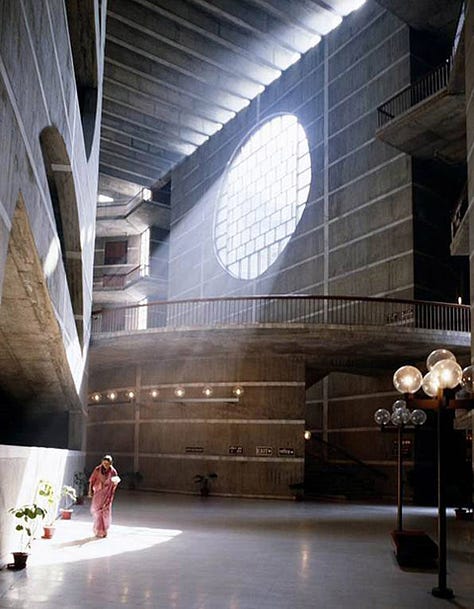
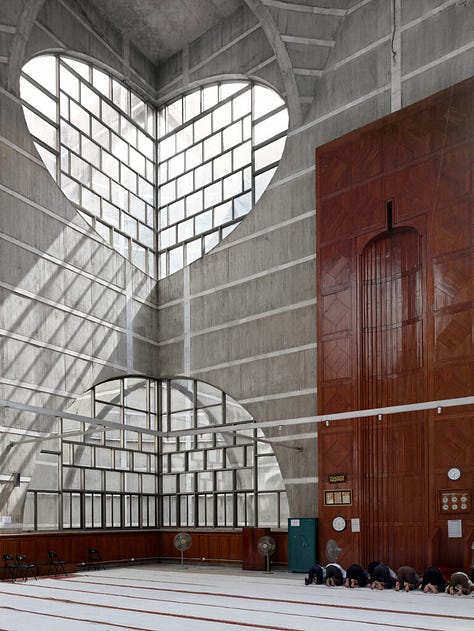
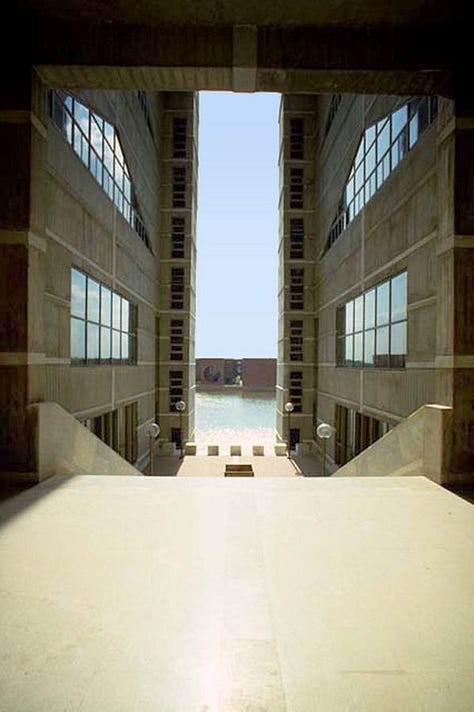
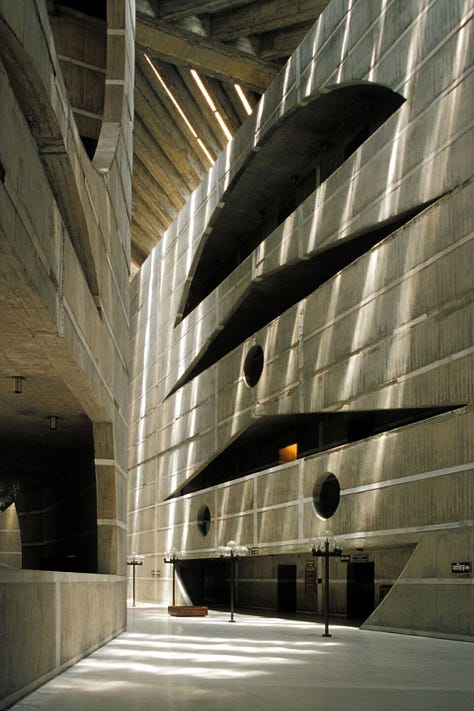
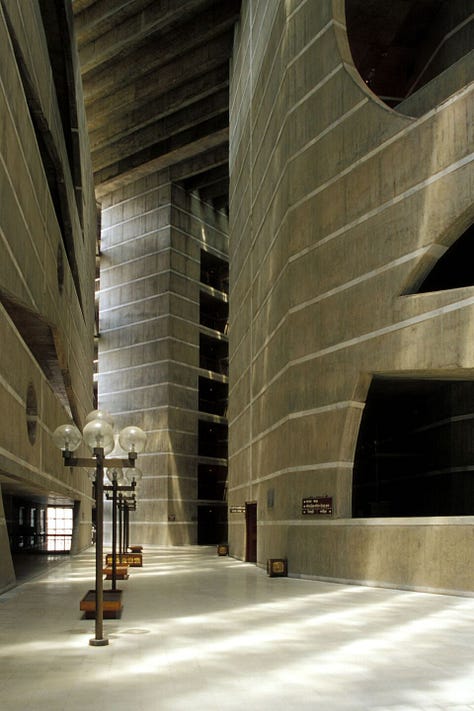
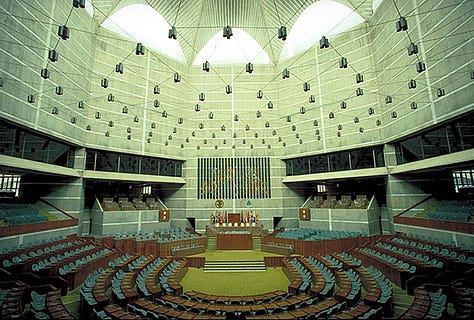
Construction was completed in 1982. The building was inaugurated on 28 January 1982 by President Abdus Sattar. The second parliament commenced its last session inside the newly built parliament on 15 February 1982. The first parliament to hold its entire session inside the Jatiya Sangshad Bhaban was the third parliament. My father, who was a member of the fourth parliament, recounted to me that he would walk in the hallways of the spectacular building praying for his election to public office. His prayers were answered when he became an MP in 1988.
In the 1980s, President H. M. Ershad hosted the OIC Foreign Ministers Meeting and the founding summit of SAARC at the newly inaugurated parliament compound. The complex continues to be a befitting site for potentially hosting international summits of the UN, OIC, and the Commonwealth. The original design of Louis Kahn included plans for a Grand Mosque and a Supreme Court. These buildings were never built when the BNP government axed the additional structures as part of budget overhauls.
Footnotes
Second capital of Pakistan under construction at Dacca in 1967 (British Pathe)
History of the Parliament Building (Bangladesh Parliament)
Jatiya Sangshad Bhaban (Banglapedia)





